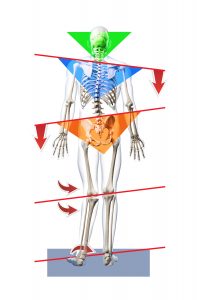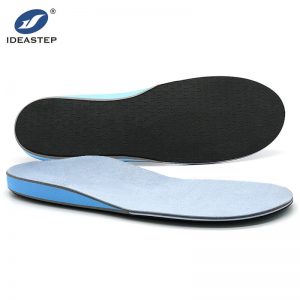Generic Insoles vs. Custom Orthotics
One of the major issues I’ve encountered as an extremity-based Chiropractor over the last 25 years is the overall lack of public education about the feet and how they affect the rest of the body. We are not properly taught about our anatomy and how different bodily parts interact and affect each other starting at a young age. This is important to remember when introducing orthotics into chiropractic care.
When people require medical attention, the vast majority of them will seek treatment through allopathic medicine. This is because they believe that pain is a sign that it is time to seek medical help. It’s common to just treat the symptoms of illnesses like plantar fasciitis, metatarsalgia, and Achilles tendonitis, rather than addressing the underlying foot/arch dysfunction and biomechanical issues that produce them. Surprisingly, many people with poor foot biomechanics go their entire lives without experiencing any foot pain. However, in my experience, upwards of 87 percent of all people in a standing posture display evidence of flat or pronating feet, which can cause pain and dysfunction in the knees, hips, pelvis, neck, and spine. Even common ailments such as shin splints and sprained ankles can be caused by poor foot function.
NOT ALL ORTHODONTICS ARE CREATED EQUALLY

The film “Crooked Man” depicts the effects of pronation (flat feet) on the entire body. Foot Levelers Custom Orthotics create a stable foundation that relieves joint stress.
Misconceptions concerning the anatomy of the arch
If you were to ask ten persons on the street, “How many arches do we have under each foot?” They’ll very certainly all say “one.” The average individual is unaware that the plantar vault of the foot is formed by three functioning arches.
NOT ALL ORTHODONTICS ARE CREATED EQUALLY
The majority of health-care providers that patients see perpetuate the belief that the inner arch is the only one that exists. People’s purchasing decisions about foot-related products, particularly orthotics, are influenced by their misconceptions. Patients must be appropriately educated about the differences between mass-produced generic insoles that advertise arch support and bespoke orthotics that address each patient’s specific biomechanics and restore natural, healthy function of all three arches, therefore stabilizing the entire body.
The term “orthotic,” or orthosis, is defined by Dictionary.com as “a device or support, especially for the foot, designed to relieve or rectify an orthopedic issue.” In and of itself, the term is a bit hazy. The orthotic industry is perplexing because it is overrun with low-cost, ready-made items.
Many brands of off-the-shelf, prefabricated, non-custom orthotics are accessible through retail/drug stores, online retailers, and some care professionals on one end of the spectrum. Customers are influenced to buy impulsively by appealing marketing and catchy words in the expectation of obtaining pain relief and increased athletic performance.
Flexible, three-arch, custom-made orthotics have been around for over 69 years on the other end of the spectrum. Only specially trained and competent health care specialists who use a weight-bearing scanning or foam casting method to analyze the feet can supply these bespoke orthotics. It is the responsibility of doctors to make these products available in their offices and to educate patients about their benefits. Let’s clarify some common orthotic terms and concepts so you can provide better care by assisting your patients in making more educated decisions.
We frequently encounter remarks like these when orthotics are advertised:
“Clinically validated”
“Designed and/or approved by a podiatrist”
“Same-day solution eliminates the need for patients to wait.”
“Quality construction” and/or “premium materials”
“Affordable”
Clinically validated:
It’s a bit of a stretch to say that prefabricated orthotics have been clinically proven. Because they usually only have one arch, they are able to assist some patients more than others. Some people don’t seem to be getting any better, if not worse. These off-the-shelf orthotics may provide some early pain alleviation if the user has a flat inner arch, but they will have no effect on the other two arches (transverse and lateral arch). Due to the lack of support, the foot will continue to flatten over time. During this time, their poor foot biomechanics may be jeopardizing their overall body’s stability and health.
Over 37 scientific research studies have been conducted on the three-arch, unique, flexible orthotics, proving its effectiveness and success with many patients. You can read and download many of the research articles, case studies, and white papers. These studies, as well as over 69 years of successful use by various health care providers around the world, demonstrate that these orthotics are incredibly beneficial.
Designed/Recommended by a Podiatrist:
The viewpoint of a podiatrist on the foot is more static than dynamic. They are exclusively concerned with the patient’s foot, ignoring the skeletal structures and corresponding joints above. They also tend to repeat the inner or single arch concept so that their patients are unaware of the importance of sustaining the three arches. Podiatric orthotic options can range from very expensive, stiff one-arch orthotics to simply instructing the patient to go to the store and pick something off the shelf. For patients, this can be extremely perplexing.
Keep in mind that the human body is a dynamic system. Knees, hips, pelvis, and spine are all influenced by the feet and ankles. We, as chiropractors, are aware of this connection. When the feet pronate excessively, it affects the rest of the body, and it contributes to some of the most prevalent clinical disorders that people seek treatment for, such as lower back discomfort.
Patients don’t have to wait with a same-day solution:
We have been accustomed to obtaining what we want quickly in our society. When people are in pain, they want to feel relief as soon as possible. The companies who sell off-the-shelf orthotics strive to take advantage of this. Rather than waiting for a custom-molded orthotic that will fully support the patient’s body, they try to persuade the consumer to accept a subpar product just because it is readily available.
Taking the effort to scan or cast the patient and have a pair of orthotics custom-molded for them assures that they will receive an exceptional product that is specifically built for their feet and body.
I may submit a bespoke orthotics order the same day after scanning and assessing a patient’s foot. The patient can pay a small fee for expedited shipping if they need them sooner. If the patient requests it, getting the custom orthotics in as soon as possible is never an issue.
High-quality materials and/or construction:
The adage “you get what you pay for” applies here. Pre-fabricated orthotics, which can be purchased off the shelf for $35-80 and are mass-produced in large quantities, are made of materials that allow them to be marketed cheaply. How can these businesses claim to be employing high-quality materials when their products are so inexpensive? When looking at the websites of these prefabricated orthotic companies to see what materials are used to make the insoles, it is clear that there isn’t much. It’s to be anticipated for a device that costs less than $100.
The three-arch, custom-fit, flexible orthotics are constructed of high-performance viscoelastic polymers that absorb shock, improve stability, and deliver a propellant boost throughout all weight-bearing activities. For over 69 years, its designs and materials have evolved depending on feedback from patients and doctors. Patients should wear their orthotics all of the time for the optimum results, therefore durability is crucial.

Low Cost:
The manufacturers of off-the-shelf orthotics expect that the low cost of their goods would appeal to consumers. This method works for them since they deal with consumers who are unfamiliar with the anatomy of the arches and feet. Their advertisements frequently emphasize the low price and fast availability.
As chiropractors, we understand the significance of the three arches and the orthotic selection for our patients. Because their pre-fabricated orthotics are of lower quality and effectiveness, we are not out to compete on price with online shops, sporting goods stores, or drugstores.
Each foot has its own set of biomechanical characteristics and problems. It’s similar to an eyeglass prescription in that both feet are analyzed separately (with a digital scanner or a foam cast), and the lens correction is usually different for each eye. Each foot requires its own specific modifications for all three arches in order to provide effective and accurate arch support and body stabilization.
Instead of an impersonal off-the-shelf option, health care providers who are skilled in prescription bespoke orthotics provide their patients a proven, value-added “experience.” There’s no need to keep inventory on-site, and the one-year money-back guarantee gives patients peace of mind that spending extra money on a high-quality product is the right decision, boosting the value of their bespoke orthotics.
To sum it up
Patients have been functioning under the false assumption that we only have one arch under each foot for far too long. With their one-arch insoles, prefabricated orthotic firms have been successful in attracting these customers by capitalizing on and spreading this myth. Give your patients information about custom orthotics, and once they grasp foot anatomy and how it affects their bodies, they’ll be open to the bespoke, three-arch, flexible orthotics you can provide as a Chiropractor.
NOT ALL ORTHODONTICS ARE CREATED EQUALLY
